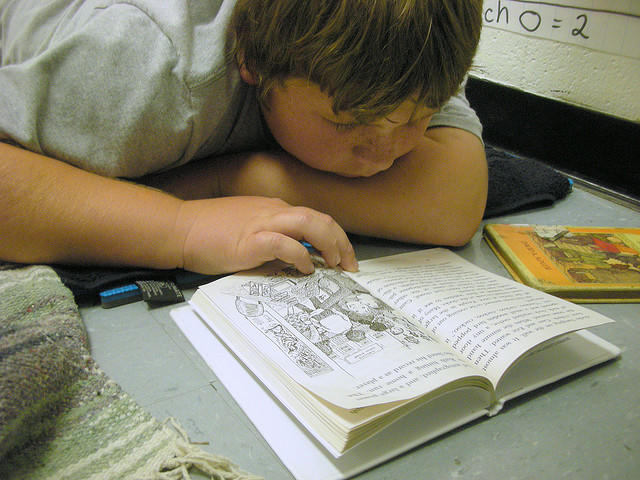
Section Branding
Header Content
The story behind the creation of 'Reading Rainbow'
Primary Content
LISTEN: GPB's Peter Biello speaks with Barbara Irwin about her book on the origins of the educational show Reading Rainbow.

The television program Reading Rainbow brought books into the lives of children and their parents for two and a half decades and made its host, LeVar Burton, nearly synonymous with adventure sparked by stories. A new book chronicles the program's origins in Buffalo, N.Y. Barb Irwin collaborated with Tony Buttino Sr. and Pam Johnson, two of the people instrumental in creating the show to write Creating Reading Rainbow: The Untold Story of a Beloved Children’s Series. She spoke with GPB’s Peter Biello.
Peter Biello: Tell us first a little bit about your role in producing Reading Rainbow.
Barbara Irwin: I had a very minor role in the production of it, but I did work on the series for three or four years and I had a hand in the book review segments that were produced in Buffalo for the first several years and did some national and local promotion for the series and also did a lot of community outreach in Buffalo and western New York, with introducing children to Reading Rainbow.
Peter Biello: So when you were at the show, the show was already basically the format that it continued with for years and years.
Barbara Irwin: It started the year before I started working on it.
Peter Biello: Okay. So when you went to write this book, you had to go back in time with the help of Tony Buttino and Pam Johnson.
Barbara Irwin: Yes. And Tony Buttino is the person who deserves credit for coming up with the idea of Reading Rainbow. He saw a need for encouraging children to read over the summer. He came across something called the summer loss phenomenon, which is common sense — the idea that children lose their reading skills over the summer because they're not reading. So teachers would have to go back a lot of times and spend maybe six weeks at the beginning of the fall school year to bring students back to the level that they were in June when school let out. And Tony ... his background was not only in production but also in instructional television — said television can definitely do something to help. So he sought to create and develop an idea for a summer series that would motivate children to read. It wasn't designed to teach kids to read. It was just designed to motivate them to keep them reading over the summer.
Peter Biello: How was this process influenced by Fred Rogers?
Barbara Irwin: Fred Rogers was very important in this. Tony went to went to see Fred Rogers as he was thinking about this idea, and he actually had proposed a series called "Mr. Rogers' Summer Vacation," knowing full well that Fred Rogers would not be able to host another series. But he presented the idea. Fred Rogers saw this as, really, a nice extension to Mister Roger's Neighborhood. Talked with Tony about how important reading is in developing parents and adults, developing relationships with children, about reading and modeling good behaviors and reading to children. And Fred modeled the type of host that Tony wanted for Reading Rainbow and that type of person. You know, a real person that had a true connection with children is what the production team found with LeVar Burton.
Peter Biello: Yeah, how did the production team find LeVar Burton?
Barbara Irwin: LeVar Burton was coming off of a big success with Roots, obviously in the late '70s.
Peter Biello: Roots, that's the television miniseries based on the Alex Haley book.
Barbara Irwin: And he was on his way to Africa for a whitewater rafting trip on the Zambezi River for American Sportsman. And he was going to be doing an interview on Live at Five in New York, a local talk newsmagazine show. And one of the producers saw that he was going to be on, called producer Cecily Truett and her husband, director Larry Lancit, and said, "let's tune in and watch this interview." And as soon as they saw LeVar on this interview, he was so engaging. Cecily called Lynne Ganek, who was the person who, producer who suggested that that Cecily watch — called Lynne and said, "Go get him." Lynne managed to connect with LeVar. He was on board. He said, "If there's a television series about reading, I'm all for it." He went off to Africa. Lynne connected with LeVar's manager, worked things out. LeVar came back from his whitewater rafting trip, was picked up at the airport and driven directly to the set of Reading Rainbow for the pilot episode. And nobody had ever met him before, and nobody on the production team had met him, and Cecily approached him, introduced — "We're very happy that you're here. Is there anything that I can get for you?" And he said, "I would love a toothbrush and a glass of orange juice," which they promptly got for him. And then they went on to produce the pilot. Tony was there on the scene and knew that LeVar was the right person for this job.
Peter Biello: How was Reading Rainbow received when it launched?
Barbara Irwin: Reading Rainbow was a tremendous success right out of the gates and 6.5 million children tuned in that first summer. And again, it was designed to be a summer reading series. So the first several years it was only in the summer. The viewership was strong. There was tremendous response from publishers who initially were very reluctant to have their books featured on the show. I mean, using television to promote books was counterintuitive at the time, but publishers saw a tremendous response as well. So books that might have been selling 5,000 copies before Reading Rainbow, they showed up as a feature book or as a review book on the show, and all of a sudden they were selling 25,000 copies. So ... publishers were very happy about this, and they started publishing the books in paperback so that they could be more accessible to more children. And if you talk with people today who grew up watching Reading Rainbow, they will say Reading Rainbow was so important to them. We talked to many people when we were working on our book, and many of them brought to tears as they were reminiscing about how important the show was to them and help them to cultivate a love for books. And this is millions upon millions of children over 26 years who watched the show.
Peter Biello: So the show started with a goal of trying to keep the love of reading alive for kids over the summer. How successful was that and how do you know?
Barbara Irwin: Well, I'm not sure that we have statistics that I could offer. But again, talking with people who grew up watching this show, what the show did was not only motivate them to read over the summer when they were beginning readers, but it developed lifelong readers and people who went into professions related to the things that they saw on the show. People who continued to read and developed a love of reading, talk with teachers, talk with librarians — huge impact that Reading Rainbow had.

